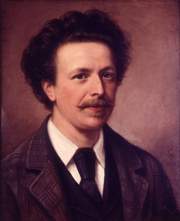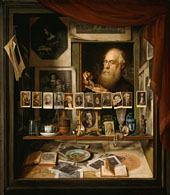Everyone loves a mystery, and this one began when Grant Holcomb, director of the Memorial Art Gallery in Rochester, purchased a painting called The Printseller’s Window at Sotheby’s in 1998. Holcomb didn’t know much about the artist, Walter Goodman, or the 1883 work, but as he recently told the Rochester Democrat & Chronicle:
I was struck by the power of it….I thought it could be the finest example of trompe l’oeil art in 19th century America.
Chief curator Majorie Searl continued:
The specificity of every object in the painting suggested a message — a mystery we had to unravel. Perhaps we should have hired Sherlock Holmes, who lived on Baker Street at the same time as Goodman.
Turns out that wasn’t necessary. Researchers, led by a Rochester lawyer named Peter Brown, who is head of the museum’s art committee, followed clues to London, and elsewhere, but — incredibly — the museum discovered that the best sources, Goodman’s descendants, lived in Rochester. They provided the museum, which has organized an exhibition about the painting, with background, documentation and a 1882 self-portrait of the artist, when he was 42. You can read more in the D&C’s article here.
What is the painting about?
 The museum sketches it as a debate between John Ruskin and, probably, Charles Darwin about the value of photography as an artistic medium. Ruskin was anti. Brown says, “He was especially critical of trompe l’oeil.”
The museum sketches it as a debate between John Ruskin and, probably, Charles Darwin about the value of photography as an artistic medium. Ruskin was anti. Brown says, “He was especially critical of trompe l’oeil.”
Again from the D&C:
That made Ruskin something of a villain for Goodman — who enjoyed photographic realism, classic Dutch still lifes and trompe l’oeil. He viewed art in a constant state of evolution, beyond the dictates of critics.
The Printseller’s Window lampoons the stuck-up art critic George Sala with a stuffy portrait encircled by pearls (an ancient symbol of vanity). Goodman also depicts celebrities’ calling cards, mass-produced ceramics and prints of Old Master paintings — all popular items in the 1880s art world. Commercial reproductions brought museum pieces into middle-class homes, which Goodman deemed a positive trend.
Mystery solved, though perhaps the exhibition, which will remain on view until Nov. 8, will bring out additional information or even competing theories.
Photo Credits: Courtesy of the Memorial Art Gallery, University of Rochester

